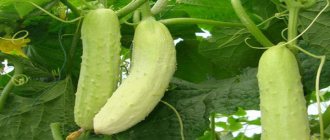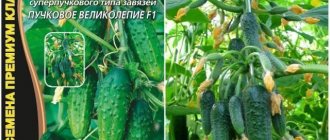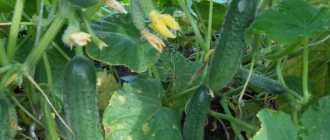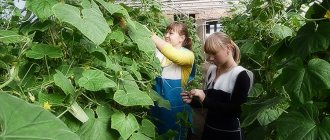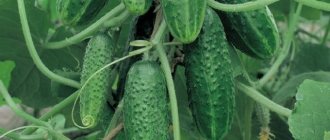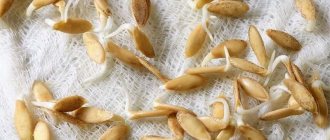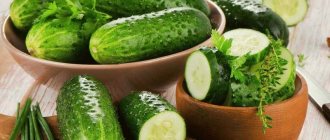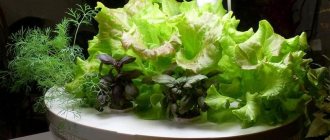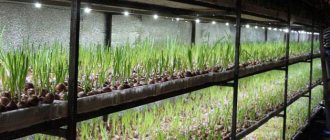Each of us has had the opportunity to buy cucumbers in the supermarket in winter - they are quite expensive and almost tasteless. "Hydroponics!" - Some buyers grin disdainfully. "No! - I answer, “it’s just a winter greenhouse, lack of lighting and a heavy dose of fertilizers at the reproductive stage.”
As you know, any plant requires a set of microelements for nutrition, which determines its qualities, including taste. And it is hydroponics that can maximize the potential of plants. This is no secret for growers - they successfully grow various agricultural crops at home, including cucumbers. Therefore, it’s worth trying to do it yourself, not only to please yourself with freshly grown herbs, say, for the New Year. But also to make sure: hydroponics is delicious.
Variety selection
Before you start growing cucumbers using the hydroponic method, you need to choose a variety. To decide, you need to consider several factors:
Ripening time
In accordance with the ripening period, cucumbers are divided into early (vegetation period up to 45 days), mid-ripening (up to 50 days) and late-ripening (over 50 days). Obviously, speed of ripening is important, and getting the first fruits after 33 days (Voyage hybrid) is very tempting. However, keep in mind: early ripening varieties have a shorter fruiting period, since everything in the plant depends on the root system. As soon as the cucumbers begin to ripen, the growth of the root system will stop, so in most cases you will not get a rich harvest from early varieties. But do not forget that with the hydroponic growing method, the ripening time of greens (in comparison with that indicated on the package of seeds) will be shorter by about five to seven days.
Varietal and hybrid
On the shoots of varietal seeds, only male inflorescences, which are located on the main vine, are first formed. They take quite a lot of energy from the plant, so most often the harvest will begin later than with hybrids. To speed up the process and also get a larger harvest, the male flowers need to be partially removed at the initial stage. In this case, when the main lash reaches a length of approximately 70 centimeters, you need to pinch it. After this, the side shoots will begin to actively develop, on which the female inflorescences (and the bulk of the cucumbers) will already be located.
Hybrids are marked F1 in their name, and at the initial stage of growth they produce female flowers, and in larger quantities. Hybrids have many advantages: excellent taste, high yield, disease resistance and less demanding temperature conditions. However, they have one drawback: the seeds of hybrids cannot be collected. In the best case, they will grow into ordinary cucumbers with signs of one of the parent varieties; in the worst case, you will get mostly barren flowers.
Obviously, the advantage of varietal cucumbers is that you don't have to buy new seeds every time. At the same time, you will select the largest ones, each time achieving a slight improvement in varietal qualities.
Salad, universal and canned
Salad varieties are not suitable for pickling and pickling due to their thicker skin, which does not allow salt solution or marinade to pass through easily (Phoenix, Altaiskiy early 166, Adam, Nerosimy 40, Sintez, Parad, etc.) Canned varieties, accordingly, are characterized by the presence of thin skin and increased content of sugars important for pickling (Favorit, Avangard, Dalnevostochny 27, Mig, Brigantina, Palchik, etc.) As the name implies, universal varieties are good both for pickling and fresh (Squadron, Farmer, Aist, Dachny , Cruise, Darling, etc.)
Pollination
Also, when choosing a variety for home cultivation, it is worth considering the pollination factor, since cucumbers are divided into bee-pollinated, partially self-pollinated and self-pollinated (parthenocarpic). When choosing bee-pollinated ones, nothing bad will happen: you just have to work a little with the bee during the flowering period, transferring pollen from male to female inflorescences. It is easy to distinguish them: male flowers always have stamens, female flowers always have a pistil. In this case, male inflorescences are most often located at the base of the stem and grow in groups. Females grow singly and have an ovary at the base that looks like a small cucumber.
Pollination can be done in two ways: using a brush or male flowers. When pollinating a flower, they do this: after picking the male inflorescence, carefully remove all the petals from it and carefully touch the stamens of no more than five female ones. To ensure pollination occurs, it can be carried out simultaneously with two or three flowers. (Hint: in order not to forget which inflorescences have already been pollinated, they need to be marked - for example, picked from the processed ones petal by petal). Pollination with a brush is also not particularly difficult - after collecting pollen from the male flower (it will settle as dry yellow dust on the bristles), you need to carefully coat the pistils on the female ones.
The advantage of hydroponics for growing cucumbers
There are many advantages to growing crops using this method both at home and on the site. Plants spend virtually no energy on the development of stems and leaves. All of them are used for fruit development. Instead of large bushes of cucumbers with leaves, in front of you will be a small bush with an impressive number of small cucumbers.
Note!
In this way, you can plant not only cucumbers, but also tomatoes, onions, radishes and peppers. The only exceptions are those vegetables that quickly rot in water: carrots, beets.
Seedlings contain much more useful microelements than bush ones. All nutrient water goes directly to the crop, not vegetation.
The best varieties for such actions will be:
- Lilliputian F1 early ripening;
- Mediarz F1;
- Zozulya;
- Marfinsky;
- Long English;
- Alma-Ata F1.
Hydroponics cucumbers have a number of other advantages:
- control of watering and fertilizing levels;
- the ability not to use pesticides and other chemicals;
- increasing productivity;
- cultivation in all parts of the Earth and in any climate;
- minimal risk of plant disease;
- a large amount of biological mass;
- cleanliness and economy.
Temperature, light and humidity conditions
Cucumber is a light-loving plant with a short day (10-12 hours). If the day lasts longer, flowering and fruiting periods are delayed, and the plant ages prematurely and produces less yield. Cucumbers also grow poorly in the shade - they shed their ovaries and become more susceptible to disease. However, if your balcony is quite shaded, do not despair - breeders have developed shade-tolerant varieties (for example, Atlet, Berendey, Razgulay, Kurazh) that can bear fruit even in your apartment.
Cucumbers are also very moisture-loving and quite demanding on temperature conditions. Ideal conditions for obtaining a rich harvest are: temperature from 20 to 27 degrees, humidity - about 75 percent. At low humidity, cucumbers will lose weight and become dry, and at temperatures below +15 (and above +42) they will simply stop growing and die. Therefore, if you live in a region with a dry climate, spraying plants with a regular spray bottle two to three times a week will not be superfluous. Naturally, the procedure should be carried out either early in the morning or in the evening, after sunset.
What is Bioponics
A new word in hydroponics was first heard in 2004, after the successful completion of experiments on growing plants using the hydroponic method using organic-based solutions. This method was developed by the French biologist William Texier. True, the method still remains very expensive to use due to the fact that:
- In hydroponic organic solutions, it is necessary to use a specially grown fungus, richoderma harzianum, whose “specialty” is the waste-free decomposition of organic compounds.
- Connections must be sterilized and certified.
- Increased aeration of the solutions used for nutrition is required.
Germination of seeds
Actually, it’s a simple and standard procedure for an experienced grower. We place the seeds in mineral wool plugs, which must be thoroughly moistened in advance. The first cotyledon leaves will appear in two to three days, at which time the plugs need to be moistened every day with plain water. Next, we water them with a nutrient solution already diluted by half, and after about a week we transfer the plugs with sprouts into mineral wool cubes (of course, the cubes also need to be pre-moistened). The sprouts should spend a week or a week and a half in the cubes, after which they can be placed in a hydroponic setup.
The process of planting cucumbers
There are a huge number of structures that can help in growing cucumbers. To create the simplest and most effective, you will need two consumables:
- Crushed stone. It is advisable to choose a smaller one.
- Expanded clay. Easily absorbs liquid and, if necessary, easily gives it to crops.
- Pipes with cut out openings.
- Pump or pump.
- Compost.
- Drinking water.
- Complex of mineral fertilizers.
DIY hydroponics for cucumbers is a simple combination of available building materials and a nutrient solution. Old plastic pipes are suitable for constructing the structure. They are placed parallel in the shape of a snake and small holes are made, 4-5 centimeters in diameter. The distance between the holes is at least 10 centimeters. A plastic cup with expanded clay and crushed stone will be placed in each hole as soil for cucumber seedlings.
You can make your own nutrient solution or purchase a ready-made solution from a specialty store. For independent production you will need:
- Hot distilled water.
- Compost.
The two ingredients are combined in a 1:2 ratio and left for 12 hours indoors at room temperature. After the recommended time has arrived, any fertilizer you use for planting at home is added to the composition. The humate obtained in the composition is removed, and the remaining volume is filled with distilled water.
The sequence of actions when transplanting cucumbers from the soil:
- Place the plant roots in water at room temperature.
- Cleaning the roots from lumps of dirt with a small stream of clean water;
- Place the roots in the prepared glass and gently spread them out.
- Water the planting with a small amount of warm water and let it take root.
The adaptation process may take up to 10 days.
Hydroponic system
When growing cucumbers, in the vast majority of cases, one of three types of systems is used: a periodic flooding system, a floating platform system (passive version with air blowing through the solution) and a drip irrigation system. However, the first option is more suitable for greenhouses, so for home use it is better to choose between the second and third options. Such systems are widely available on the market, but they are quite easy to make yourself.
The floating platform system in our case will look like this: a nutrient solution is poured into a container located on the balcony (or in the room), placing tubes with air holes connected to the compressor on the bottom. A sheet of plastic/chipboard/fibreboard/plywood with holes cut for pots is placed on the container (if the material is not white, painting will be needed - thanks to light reflection, the roots will heat up less on sunny days). Pots with holes or grooves are inserted into the slots. Naturally, the width of the slots should be smaller than the substrate granules so that it does not fall out into the container. Cucumbers will quickly grow through the substrate, putting down roots directly into the container with the nutrient solution. The plant will receive oxygen through aeration. Naturally, the main difficulty in operating this system is replacing the nutrient solution, but this procedure will have to be carried out once or twice per cycle (depending on the number of plants), so this option is worth considering.
The drip irrigation system is a little simpler, but it requires a little more equipment. A simple scheme: the nutrient solution from the container, using a pump, enters tubes with dispensers, which are connected to the root zone of each plant. The pots are located on a tray with sides, which is installed with a very slight slope towards the drain hole. Water flows through the slots in the pots onto the tray, and under the influence of gravity it again ends up in the main container, which is located below the tray. In this case, much less solution will be needed, and working with it will be much easier. However, you will naturally need a water pump with a timer. If there are frequent power outages in your area, also take care of the battery or uninterruptible power supply.
Hydroponics technology: types of systems by irrigation method
The main principle of the technology is to provide plants with sufficient water and nutrients. There are several types of irrigation, according to which six hydroponic systems are distinguished:
- Wick. The only passive design that works without an electrical connection. Water is delivered to the roots through the wick. The disadvantage of the system is the transportation of a small amount of liquid, which is not suitable for all crops. The advantage is the absence of equipment and elements that can fail.
- Nutrient layer - among the active ones, this is the simplest technique. The solution is started by a pump and constantly moves from one end of the tank to the other, washing the roots of the plants. It is necessary to monitor the composition of the liquid and replace it if the pH level is low.
- Periodic flooding system. With it, the solution is started by the pump strictly according to a timer at regular intervals. This allows you to reduce excess liquid so you don't have to reuse it.
- Drip irrigation is carried out using tubes connected to each root. The pump releases water that drips under the base of the plants. This is how dosed irrigation and oxygen saturation are carried out.
- Deep water culture system. Suitable for growing moisture-loving crops that do not reach large sizes. Because they are placed on a floating foam base. At the bottom there is a reservoir with liquid, the presence of oxygen is provided by a pump.
- Aeroponics - involves the suspended position of plants above the solution. The pumps spray the liquid, resulting in small droplets. This provides the required amount of nutrients, humidity, and oxygen.
All active systems have one common drawback - dependence on the power supply. However, they are the most cost-effective and beneficial for industrial production on a large scale.
Substrate
Apparently, cucumber is not a particularly demanding crop for substrate - for example, when growing cucumbers in large production areas, crushed stone or gravel of fractions of 3-8 millimeters is used in this capacity. The main motive for this choice is simple - this substrate is almost eternal, and to prevent salinization when replacing the nutrient solution, it is simply washed with water. However, the moisture-retaining properties of such a substrate are zero, which is fraught with the rapid death of cucumbers in the event of a power outage. Plus, let's not forget about weight. Therefore, it is still worth stopping at expanded clay, a standard filler for hydroponic systems of the two types mentioned above.
Hostage to cucumbers
Before the increased water requirements of cucumbers (and the aforementioned consequences thereof) became apparent to me, I was growing cucumbers in 13-liter hydroponic containers, which are originally designed for medium-sized peppers, whose daily water needs are much more modest (about 2-3 l per day). Of course, cucumbers used up this reserve much faster. In addition, the root system of a cucumber is approximately two to three times larger than the roots of a pepper, and during the season it can grow so luxuriantly that it begins to occupy up to half the volume of the tank, leaving less and less space for the nutrient solution.
It is not surprising that during the summer I had to run to the balcony every day with a bucket and add water to the rapidly emptying cucumber containers. Thus, I could not leave the house even for a day, because without timely watering, the insatiable cucumber vine could easily dry out in the bright sun.
The cucumbers, of course, were very happy with this care. But how comfortable is this arrangement for the grower himself? Depends on the circumstances. If you don’t need to go anywhere during the season, no problem. But what if you need to go on vacation for a week, and there is no one to look after your plants?.. This is exactly the situation I found myself in the midst of the 2018 summer season. And since being held hostage (even by cucumbers) is not very pleasant, I realized that the tanks of cucumber containers need to be radically increased in order to be able to leave the house for at least a few days, without fear that in my absence the cucumbers will die from thirst.
Nutrient solution
Since the plantation is located in an apartment, it is obvious that tap water will be used. This is a good option, considering the number of stages of cleaning it goes through. The only point about water treatment is that it will need to sit for a couple of days in an open container so that the chlorine evaporates and the salts settle (ideally, it should be poured into a container with a nutrient solution through a hole located 5-10 centimeters above the bottom so that the salts do not get into the solution - there will be enough of our own there anyway).
The main indicators of the ready-made solution for cucumbers are pH 5.5-6.2, EC - 2.2-2.7 (in case of insufficient light in late autumn or winter, it may be slightly lower - from 1.7 to 2.2).
Recommended nutrient solution composition:
| Source | Concentration |
| Calcium Nitrate | Ca - 200 ppm N - 140 ppm |
| Potassium Sulfate | S - 150-250 ppm |
| Monopotassium Phosphate | P - 50 ppm K - 350 ppm |
| Iron Chelate (FeDTPA) | Fe - 3 ppm |
| Magnesium Sulfate | Mg - 50 ppm |
| Copper Sulfate | Cu - 0.07 ppm |
| Manganese Sulfate | Mn - 0.8 ppm |
| Zinc Sulfate | Zn - 0.1 ppm |
| Sodium Molybdate | Mo - 0.03 ppm |
| Boric Acid | B — 0.3 ppm |
Conditions for growing crops
Growing cucumbers hydroponically at home is not difficult. Moreover, this method prevents the development of various diseases and rotting in plants. It is worth considering that the crop loves free space, so no more than two seedlings can be placed in one 1m*1m container.
The second important point is light. To increase the impact of lighting, you can take advantage of an increase in the concentration of carbon dioxide in the air. If you follow the rules for preparing the solution, the growing process will be much faster and easier.
Solution components:
- 0.25 g copper;
- 0.25 g magnesium sulfate;
- 1 g calcium;
- 0.25 g sodium;
- 0.75 g zinc;
- 0.25 g potassium sulfate.
The optimal acidity level should be between 5.5-6.
If there is a lack of useful elements, the crop will be dominated by leaves rather than fruits.
Location and garter of cucumbers
And lastly, to get a good harvest you need to build a good support. When the cucumber stem reaches about 30 centimeters in length and 4-6 true leaves appear on it, you need to start tying it up. Before this time, the crop does not need support, but at a later date, when gartering, the stem can easily be broken. Therefore, you need to prepare in advance by stretching two horizontal ropes at the top and bottom of the balcony (naturally, closer to the window). You can attach a special net for climbing plants, fabric strips or just ropes to them. Typically, the distance between plants is from 30 to 50 centimeters, in which case they will not overlap each other much. There is only one last point left: be sure to pinch stems that are longer than 2 meters - otherwise they will begin to shade the cucumbers with growing shoots, as a result of which the yield may be significantly reduced.
Hydroponic cucumbers
Every gardener knows that cucumbers are climbing plants by nature. In a small hydroponics garden for individual use, cucumbers should be sown along the wall of the tray, and then their shoots should be tied to supports installed at an angle of 45°. With this placement, cucumbers do not interfere with other plants located in the same tray. Tied cucumbers produce fruits of much better quality. Daylight hours for optimal growth of cucumbers are up to 14 hours. Lighting equipment, which you can purchase on our website - Promhydroponics.RF Conventionally, the entire process of growing cucumbers can be divided into several stages, will help you achieve the optimal duration of daylight hours and good harvests. Sowing - growing in cassettes. Planting - growing in cubes. And the last stage is growing in mats.
Hydroponic Methods for All Tomato Varieties
Not only the bag growing method is popular, but also the hydroponics method. There are several basic hydroponic techniques applicable to growing cucumbers. Among them:
- Periodic flooding method. It involves planting the crop on a porous substrate, which is periodically filled with liquid containing useful substances.
- Method of watering cucumbers. Suitable for indoor use as it does not require the use of manure. It involves setting up a system with two connected containers, one of which contains plant roots. Periodically, water with nutrients is poured into this container. This method allows you to avoid photo lamps even when growing vegetables indoors.
- Floating platform method. It involves planting plants in special blocks, for example, a mineral wool substrate, with their further installation in reservoirs with nutrient liquid. Using this method helps prevent root rotting.
- Aeroponics. Allows you to dispense with soil mixture. This technology involves moistening the plant roots with special aerosols containing nutrients. This method is not used at home; it is only suitable for specialized greenhouses.
Read about how often you need to water tomatoes in a greenhouse here.
For cucumbers, the most effective hydroponic growing method is the intermittent flooding method. It is suitable for greenhouses. The advantages of this method are the simplicity of organizing a hydroponic installation, high crop yield and minimal influence on the growing process of external factors, including climatic ones.
Advantages and disadvantages of the method
When planning to make hydroponics for cucumbers with your own hands and reap a good harvest, you should carefully study all the pros and cons of the technological process.
The advantages include:
- Controlling nutrient intake. The composition for hydroponic cucumbers is prepared independently and added to the water in the required quantities.
- The culture absorbs the required amount of liquid to ensure full growth.
- The root system is not hidden by the soil, which allows you to monitor its condition and maintain the required level of oxygen.
- Minimal risk of plant disease. As a result, there is no pesticide treatment, which has a positive effect on the taste and size of the fruit.
- Due to the high nitrogen content in the material, a lot of biological mass is produced.
The disadvantages of the method are also important to consider:
- The yield and health of the plant directly depend on its care. If the substrate for cucumbers is prepared without complying with the established parameters, the death of the plant may occur. It is necessary to maintain the level of nutrients and acidity.
- The temperature in the root zone should be +22-24 degrees. Exceeding these indicators will lead to the death of the root system.
- Hydroponics speeds up the process of growing vegetables, but is quite expensive.
- The use of plastic pipes and mineral salts is not acceptable for everyone.
